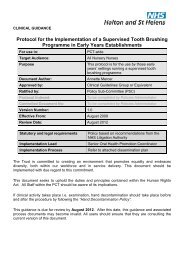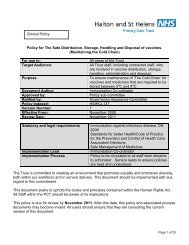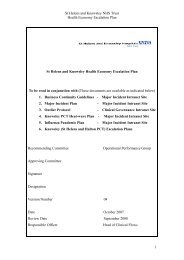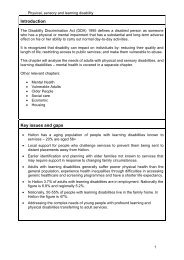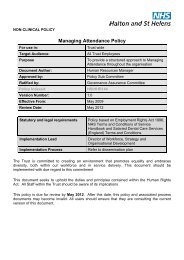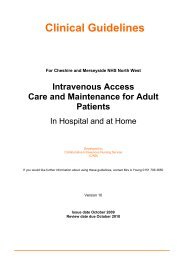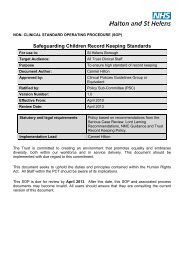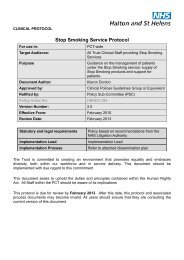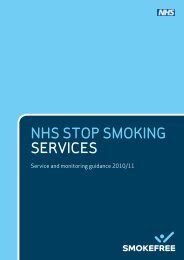Clinical Guidelines for PEG placement - Halton and St Helens PCT
Clinical Guidelines for PEG placement - Halton and St Helens PCT
Clinical Guidelines for PEG placement - Halton and St Helens PCT
Create successful ePaper yourself
Turn your PDF publications into a flip-book with our unique Google optimized e-Paper software.
<strong>Halton</strong> <strong>and</strong> <strong>St</strong> <strong>Helens</strong> Division<br />
CLINICAL GUIDANCE<br />
<strong>Clinical</strong> <strong>Guidelines</strong> <strong>for</strong><br />
<strong>PEG</strong> <strong>placement</strong><br />
For use in:<br />
<strong>Halton</strong> <strong>and</strong> <strong>St</strong> <strong>Helens</strong> Division<br />
Target Audience:<br />
All Trust <strong>Clinical</strong> <strong>St</strong>aff<br />
Purpose:<br />
The purpose of this document is to outline the<br />
processes <strong>and</strong> procedures involved when<br />
requesting a <strong>PEG</strong> <strong>for</strong> a patient in the<br />
community. The document includes criteria <strong>for</strong><br />
selection <strong>and</strong> the paperwork required <strong>for</strong><br />
completion<br />
Document Author:<br />
Heulwen Sheldrick <strong>and</strong> the Community <strong>PEG</strong><br />
care pathway development group.<br />
Approved by:<br />
<strong>Clinical</strong> <strong>Guidelines</strong> Group or Equivalent<br />
Ratified by:<br />
<strong>Clinical</strong> Quality <strong>and</strong> <strong>St</strong><strong>and</strong>ards Group<br />
Policy Index No:<br />
H<strong>St</strong>HCL304<br />
Version Number: 1.0<br />
Effective From: July 2011<br />
Review Date: July 2014<br />
<strong>St</strong>atutory <strong>and</strong> legal requirements Mental Capacity Act 2005<br />
Implementation Lead<br />
Community <strong>PEG</strong> care pathway development<br />
group<br />
The Trust is committed to creating an environment that promotes equality <strong>and</strong> embraces<br />
diversity, both within our work<strong>for</strong>ce <strong>and</strong> in service delivery. This document should be<br />
implemented with due regard to this commitment.<br />
This document seeks to uphold the duties <strong>and</strong> principles contained within the Human Rights<br />
Act. All <strong>St</strong>aff within the <strong>PCT</strong> should be aware of its implications.<br />
If clinical activity takes place i.e. examination, h<strong>and</strong> decontamination should take place be<strong>for</strong>e<br />
<strong>and</strong> after the procedure by following the “H<strong>and</strong> Decontamination Policy”.<br />
This guidance is due <strong>for</strong> review by July 2014. After this date, this guidance <strong>and</strong> associated<br />
process documents may become invalid. All users should ensure that they are consulting the<br />
current version of this document.
Key individuals involved in developing the document (Internal <strong>St</strong>aff Only)<br />
Name(s)<br />
Designation<br />
Heulwen Sheldrick<br />
Specialist Speech <strong>and</strong> Language Therapist<br />
Distributed to the following <strong>for</strong> approvals <strong>and</strong> comments<br />
Committee(s)<br />
Members of the Policy Sub Committee (PSC)<br />
Members of the <strong>Clinical</strong> Policies <strong>Guidelines</strong><br />
Group (CPG)<br />
Community <strong>PEG</strong> care pathway development<br />
group<br />
Individual(s) (Include email address of external<br />
individuals (NON NHS))<br />
Designation<br />
Dr Salahudin Khalid<br />
Deborah Eckersley,<br />
Rhian King<br />
Anne Betteley<br />
Janet Dougherty<br />
Rachel Brown<br />
Dr P O’Toole (acknowledgements <strong>for</strong> selection<br />
criteria guidance)<br />
Dr G.P Butcher (acknowledgements <strong>for</strong> selection<br />
criteria guidance)<br />
Prof C.F Kiire (acknowledgements <strong>for</strong> selection<br />
criteria guidance)<br />
C/N V.Fletcher (acknowledgements <strong>for</strong> selection<br />
criteria guidance)<br />
Consultant Gastroenterologist, Warrington<br />
<strong>and</strong> <strong>Halton</strong> Hospitals NHS Trust<br />
Advanced Dietitian, Warrington <strong>and</strong> <strong>Halton</strong><br />
Hospitals NHS Trust<br />
SLT, Warrington <strong>and</strong> <strong>Halton</strong> Hospitals NHS<br />
Trust<br />
Advanced Dietitian, Warrington <strong>and</strong> <strong>Halton</strong><br />
Hospitals NHS Trust<br />
Endoscopy Specialist Nurse, Warrington<br />
<strong>and</strong> <strong>Halton</strong> Hospitals NHS Trust<br />
SLT, 5 Boroughs Partnership Trust<br />
Consultant Gastroenterologist, Aintree<br />
Consultant Gastroenterologist, Southport<br />
Consultant Gastroenterologist, Southport<br />
Upper GI Nurse Practitioner, Southport<br />
Page 2 of 27
Revision History <strong>and</strong> Version Control<br />
Revision<br />
Date<br />
Reason <strong>for</strong> Change Version No. By Who Version No.<br />
Jul 11 New Document H Sheldrick 1.0<br />
Page 3 of 27
Table of Contents<br />
<strong>Clinical</strong> <strong>Guidelines</strong> <strong>for</strong> decision making about..............................................................................5<br />
<strong>PEG</strong> <strong>placement</strong>............................................................................................................................5<br />
Categories 1-4...........................................................................................................................5<br />
Category 5.................................................................................................................................6<br />
Category 6.................................................................................................................................7<br />
Category 7.................................................................................................................................7<br />
Category 8.................................................................................................................................8<br />
Category 9.................................................................................................................................8<br />
Procedure <strong>for</strong> requesting a <strong>PEG</strong> ..................................................................................................9<br />
References.................................................................................................................................10<br />
Appendix 1 .................................................................................................................................11<br />
Glossary of Terms ...................................................................................................................11<br />
Appendix 2 .................................................................................................................................12<br />
Contact Details ........................................................................................................................12<br />
Appendix 3 .................................................................................................................................13<br />
<strong>PEG</strong> Placement Care Pathway ...............................................................................................13<br />
Appendix 4 .................................................................................................................................25<br />
Equality Impact Assessment Tool ...........................................................................................25<br />
Appendix 5 .................................................................................................................................26<br />
Dissemination <strong>and</strong> Training Plan.............................................................................................26<br />
Page 4 of 27
<strong>Halton</strong> <strong>and</strong> <strong>St</strong> <strong>Helens</strong> Division<br />
CLINICAL GUIDELINES FOR DECISION MAKING ABOUT<br />
<strong>PEG</strong> PLACEMENT<br />
<strong>PEG</strong> feeding should be considered <strong>for</strong> any patient who is unable to meet his/her nutritional requirements<br />
via the oral route <strong>and</strong> who is likely to require artificial nutritional support <strong>for</strong> at least four weeks<br />
There are a number of clinical conditions which may lead to a difficulty in meeting nutritional<br />
requirements via the oral route; they can be divided into the following broad areas: Categories 1-9<br />
Categories 1-4<br />
1. Mechanical dysphagia due to obstruction in the upper aero-digestive tract<br />
e.g. head & neck cancer<br />
2. Neurological dysphagia, where there is the prospect of recovery from the underlying<br />
disease<br />
e.g. some acute strokes<br />
3. Inability to eat due to global neurological damage, where there is the prospect of<br />
recovery from the underlying disease<br />
e.g. brain injury, reversible coma<br />
4. Where there is no problem with eating, but nutritional requirements are increased due<br />
to malabsorption<br />
e.g. cystic fibrosis, Crohn’s disease<br />
<strong>Guidelines</strong><br />
<strong>PEG</strong> should be recommended unless<br />
i) Prognosis is so poor that survival beyond a few weeks in unlikely.<br />
In the terminal stages of life it is common <strong>for</strong> the patient to lose the desire to eat, <strong>and</strong> there is no<br />
evidence that providing nutrition in this situation improves the patient’s well-being.<br />
ii)<br />
The patient refuses treatment <strong>and</strong> is legally competent to do so.<br />
The Mental Capacity Act 2005 states that everyone should be treated as able to make their own<br />
decisions until it is shown that they are not.<br />
A person is unable to make a decision if he is unable to:<br />
Page 5 of 27
a) underst<strong>and</strong> the in<strong>for</strong>mation relevant to the decision<br />
b) retain that in<strong>for</strong>mation<br />
c) use or weigh up that in<strong>for</strong>mation as part of the process of making the<br />
decision<br />
d) to communicate his decision (whether by talking, sign or other means)<br />
The in<strong>for</strong>mation relevant to a decision includes in<strong>for</strong>mation about the reasonably <strong>for</strong>eseeable<br />
consequences of<br />
a) deciding one way or another<br />
b) failing to make the decision.<br />
iii)<br />
The patient has lost the capacity to make decisions, but has made an advanced decision<br />
about artificial feeding being withheld<br />
Under the Mental Capacity Act 2005 an advanced decision means a decision made by a person<br />
after he has reached 18, <strong>and</strong> when he has capacity to do so that if<br />
a) at a time <strong>and</strong> in such circumstances as he may specify, a specified treatment is<br />
proposed to be carried out or continued by a person providing health care <strong>for</strong> him, <strong>and</strong><br />
b) at that time he lacks capacity to consent to the carrying out or continuation of<br />
treatment, the specified treatment is not to be carried out<br />
iv)<br />
The patient has lost capacity, but has appointed a Lasting power of attorney<br />
<strong>and</strong> they have refused treatment.<br />
An appointed Lasting Power of Attorney has the authority to make decisions about the person’s<br />
health <strong>and</strong> welfare when the person has lost capacity to make their own decisions<br />
v) The patient has lost the capacity to make a decision, but <strong>PEG</strong> feeding would prolong a life that<br />
is ‘demonstrably awful’ due to pain <strong>and</strong> distress.<br />
This should be discussed <strong>and</strong> agreed in a ‘Best Interests’ meeting<br />
Category 5<br />
Inability to eat due to dementia<br />
<strong>Guidelines</strong><br />
<strong>PEG</strong> is not generally indicated, except in particular circumstances<br />
Patients with advanced dementia frequently develop oral feeding problems, eating difficulties or<br />
an indifference to food. This is often in the late stages of the illness where it is not possible to<br />
underst<strong>and</strong> the patient’s wishes. The Alzheimer’s Society states that ‘Quality of life rather than<br />
length of life should be prioritised’<br />
Page 6 of 27
In a review of <strong>PEG</strong> <strong>placement</strong> in dementia, <strong>PEG</strong> was seldom effective in improving nutrition,<br />
maintaining skin integrity, preventing aspiration pneumonia, in improving functional status or<br />
extending life.<br />
However, a diagnosis of dementia should not rule out consideration <strong>for</strong> <strong>PEG</strong>. <strong>St</strong>udies do not<br />
prove that <strong>PEG</strong> is never indicated in patients with dementia, but do show that the indication is<br />
rare. An example of this may be when feeding is so distressing <strong>for</strong> a patient that <strong>PEG</strong> may be<br />
seen to be in their best interest.<br />
In general, careful h<strong>and</strong> feeding following multidisciplinary assessment <strong>and</strong> identification of risks<br />
<strong>and</strong> benefits is preferred, <strong>and</strong> gastrostomy should not be offered in advanced dementia.<br />
Where the dementia is not the primary cause of the eating difficulty, <strong>for</strong> example a patient with<br />
dementia who has had a stoke, considerations described under the relevant category should<br />
apply.<br />
Category 6<br />
Where there is no malabsorption or dysphagia but chronic disease is<br />
causing weight loss due to lack of appetite <strong>and</strong>/or increased catabolism<br />
e.g chronic renal failure<br />
<strong>Guidelines</strong><br />
<strong>PEG</strong> is not generally indicated, except in particular circumstances<br />
In some chronic disease states the nutritional deficit is due to alterations in intermediate<br />
metabolism that are refractory to nutritional therapy (the anorexia-cachexia syndrome). <strong>PEG</strong><br />
feeding is futile in these situations<br />
When anorexia is less profound, the loss of appetite can often be overcome by appropriate<br />
dietary manipulation <strong>and</strong> appetite enhancers. If appetite is likely to improve within 4-6 weeks,<br />
short-term NG feeding may be appropriate. This would be an exceptional decision in the<br />
community<br />
<strong>PEG</strong> feeding has been shown to be of benefit in a few specific chronic conditions most notably<br />
renal failure patients on dialysis.<br />
Category 7<br />
Neurological dysphagia, where the cause is a progressive<br />
neurological disorder without the prospect of recovery<br />
e.g. Motor Neurone Disease, Multiple Sclerosis, Cerebral Palsy.<br />
<strong>Guidelines</strong><br />
<strong>PEG</strong> may be offered<br />
Page 7 of 27
<strong>PEG</strong> should be discussed with the patient, pointing out the risks <strong>and</strong> benefits of the procedure.<br />
The timing of the discussion around the consideration <strong>for</strong> <strong>PEG</strong> is very important in progressive<br />
neurological diseases. If possible, they should be allowed time to accept their diagnosis, be<strong>for</strong>e<br />
<strong>PEG</strong> is mentioned, but should not be left too late as in some cases they may derive little benefit if<br />
the procedure is not carried out soon enough, <strong>and</strong> may not even be possible if the patient is too<br />
unwell.<br />
Category 8<br />
Inability to eat due to severe neurological damage, where there is no<br />
prospect of recovery from the underlying disease<br />
e.g. Minimally responsive state, severe stroke<br />
<strong>Guidelines</strong><br />
A trial of <strong>PEG</strong> feeding may be considered<br />
In situations where severs neurological disease has resulted in total or near total loss of<br />
awareness, <strong>and</strong> there is no realistic prospect of improving, the concept of ‘quality of life’ looses its<br />
meaning<br />
Recognition that the patient is in this state requires skilled multidisciplinary assessment.<br />
In many such cases the patient’s condition is so poor that death is inevitable whatever treatment<br />
is provided. In these circumstances <strong>PEG</strong> is contraindicated <strong>for</strong> reasons outlined above.<br />
If the patient’s condition has stabilised, the only purpose of <strong>PEG</strong> feeding is to maintain life <strong>and</strong><br />
organ function. This is not necessarily in the patient’s best interests, as recognised by law, <strong>and</strong> in<br />
some circumstances the doctor may be justified in withholding <strong>PEG</strong> feeding.<br />
In view of the uncertainty of medical prognosis, a trial of <strong>PEG</strong> feeding may be appropriate to<br />
allow time <strong>for</strong> further assessment. This should be undertaken <strong>for</strong> a predetermined period with<br />
prearranged review <strong>and</strong> the nature <strong>and</strong> purpose of the trial should be made unambiguously clear<br />
at the outset to all those involved in the patient’s care <strong>and</strong>, where appropriate, the relatives.<br />
Category 9<br />
Refusal to eat because of a psychiatric disorder<br />
e.g. depression, anorexia nervosa<br />
<strong>PEG</strong> <strong>placement</strong> is best avoided<br />
Patient’s who refuse to eat due to a psychiatric disorder will usually also refuse tube feeding <strong>and</strong><br />
their autonomy should be respected (unless they are being treated <strong>for</strong> anorexia nervosa under<br />
the provision of the mental Health Act, 1983)<br />
Nasogastric tube feeding may be en<strong>for</strong>ced under the Mental Health Act <strong>for</strong> anorexia nervosa, but<br />
this is usually temporary measure <strong>and</strong> the question of <strong>PEG</strong> insertion rarely arises.<br />
Page 8 of 27
PROCEDURE FOR REQUESTING A <strong>PEG</strong><br />
ACTION<br />
1. It is the responsibility of the person<br />
initiating referral <strong>for</strong> a <strong>PEG</strong> to<br />
contact all members of the multidisciplinary<br />
team, <strong>and</strong> ask them to<br />
complete their sections of the <strong>PEG</strong><br />
care pathway.<br />
2. As much detail as possible should<br />
be included so a fully in<strong>for</strong>med<br />
decision can be made<br />
3. All sections of the <strong>PEG</strong> care<br />
pathway should be collated by the<br />
person initiating referral.<br />
4. The fully completed pathway should<br />
then be sent to Gastroenterology,<br />
<strong>and</strong> following this an out patient<br />
appointment will be arranged.<br />
5. If it is appropriate to proceed with<br />
the <strong>PEG</strong> following the out-patient<br />
appointment, arrangements will be<br />
made <strong>for</strong> the patient to be admitted<br />
<strong>for</strong> the procedure.<br />
6. If the patient is not able to attend an<br />
out-patient appointment, they may<br />
be given the option of a domiciliary<br />
visit to see if <strong>PEG</strong> is appropriate.<br />
7. If there is some disagreement<br />
between members of the MDT as to<br />
whether <strong>PEG</strong> is appropriate, then it<br />
may be necessary to hold a best<br />
interest meeting so a joint decision<br />
about the management of the<br />
patient can be made.<br />
RATIONALE<br />
To ensure all professionals concerned input<br />
into the decision making process.<br />
To ensure a fully in<strong>for</strong>med decision can be<br />
made.<br />
To ensure all in<strong>for</strong>mation collated is<br />
available on the <strong>for</strong>m<br />
The ensure patient is seen preoperatively<br />
by the appropriate consultant<br />
To ensure appropriate patients undergo<br />
procedure if this is deemed appropriate<br />
To ensure patient is seen if the patient can<br />
not attend out-patient appointment<br />
To ensure a joint decision about the<br />
management of the patients care can be<br />
made.<br />
Page 9 of 27
REFERENCES<br />
Reference<br />
Withholding or withdrawing life-prolonging medical<br />
treatment. British Medical Association. BMJ Books<br />
1999<br />
Ethical & legal aspects of clinical hydration <strong>and</strong><br />
nutritional support.<br />
ed Lennard-Jones, JE . BAPEN 1998<br />
Gillick MR. Rethinking the role of tube feeding in<br />
patients with advanced dementia.<br />
NEJM 2000; 342: 206-10<br />
Finucane TE, Bynum JPW. Use of tube feeding to<br />
prevent aspiration pneumonia.<br />
Lancet 1996; 348: 1421-24<br />
Rabeneck L, McCullogh LB, Wray NP. Ethically<br />
justified, clinically comprehensive guidelines <strong>for</strong><br />
percutaneous endoscopic gastrostomy tube<br />
<strong>placement</strong>.<br />
Lancet 1997; 349: 496-98<br />
Oral feeding difficulties <strong>and</strong> dilemmas. A guide to<br />
practical care, particularly towards the end of life.<br />
Royal College of Physicians. Jan 2010<br />
Relevance (whole<br />
document or section,<br />
please state)<br />
Whole document 1<br />
Whole document 1<br />
Whole document 1<br />
Whole document 1<br />
Whole document 1<br />
Whole document 1<br />
The Mental Capacity Act 2005 Whole document 1<br />
Evidence<br />
Grade<br />
Page 10 of 27
APPENDIX 1<br />
Glossary of Terms<br />
<strong>PEG</strong> – Percutaneous Endoscopic Gastrostomy – a tube inserted endoscopically into a<br />
patient’s stomach – to provide enteral feeding when non-oral feeding is affected.<br />
Page 11 of 27
APPENDIX 2<br />
Gastroenterology Secretaries<br />
Warrington Hospital<br />
Lovely Lane<br />
Warrington<br />
WA5 1QG<br />
Tel 01928 753085<br />
Fax 01928753119<br />
Contact Details<br />
Warrington<br />
<strong>Halton</strong><br />
Adult Speech & Language Therapy Speech & Language Therapy<br />
Warrington Hospital<br />
<strong>Halton</strong> Hospital<br />
Lovely Lane<br />
Hospital Way<br />
Warrington<br />
Runcorn<br />
WA5 1QG<br />
WA7 2DA<br />
Tel 01925 662062 Tel 01928 753424<br />
Fax 01925 662923 Fax 01928 753313<br />
Speech & Language Therapy<br />
Speech & Language Therapy<br />
Adult Learning Disabilities Service Adult Learning Disabilities Service<br />
7-9 Wilson Pattern <strong>St</strong> The Bridges Learning Centre<br />
Warrington<br />
Crow Wood Health Park<br />
WA1 1PG<br />
Crow Wood Lane<br />
Tel 01744 457278 Tel 0151 4955300<br />
Fax 01744 457258 Fax 0151<br />
Dietetic Department<br />
Dietetic Department<br />
Warrington Hospital<br />
<strong>Halton</strong> Hospital<br />
Lovely Lane<br />
Hospital Way<br />
Warrington<br />
Runcorn<br />
WA5 1QG<br />
WA7 2DA<br />
Tel 01925 662459 Tel 01928 753202<br />
Fax 01925 662923 Fax 01928 753411<br />
Page 12 of 27
APPENDIX 3<br />
<strong>PEG</strong> Placement Care Pathway<br />
For use in the community<br />
This <strong>for</strong>m should be used to refer a patient to the gastroenterology team <strong>for</strong> consideration <strong>for</strong><br />
<strong>PEG</strong> <strong>placement</strong>. ALL relevant sections MUST be completed or the <strong>for</strong>m may be returned.<br />
Section One<br />
to be completed the professional initiating the procedure<br />
Patient Name ………………………………………..<br />
DOB …………………<br />
Address ………………………………………………………………………………………………<br />
……………………………………………………<br />
NHS no ……………………….<br />
GP ………………………………………………<br />
Postcode ……………………………<br />
Hospital no (if known) ………………<br />
Surgery ……………………………………….<br />
Patient’s next of kin ……………………………….Relationship to patient ………………….....<br />
1.1 When considering a patient <strong>for</strong> <strong>PEG</strong> <strong>placement</strong>, the following must be considered<br />
The patient must have been seen by a Dietitian <strong>and</strong> or<br />
Speech & Language Therapist (as appropriate)<br />
Is enteral tube feeding likely to be required <strong>for</strong> more than 14<br />
days<br />
Unable to meet nutrition, hydration or medication<br />
requirements by oral intake<br />
Risk of significant malnutrition <strong>and</strong> / or delayed recovery<br />
Is the patient’s medication suitable <strong>for</strong> administration via<br />
<strong>PEG</strong><br />
Yes<br />
(present)<br />
No<br />
(absent)<br />
Page 13 of 27
1.2 Where is the patient currently living<br />
Home alone<br />
Home with carers<br />
Home with family<br />
Nursing Home<br />
Other e.g. hospice ………………………………………………..<br />
1.3 Will <strong>PEG</strong> be able to be managed in the current home environment …………………..<br />
…………………………………………………………………………………………………………<br />
1.4 Is the patient able to attend an out-patient appointment YES NO<br />
at the hospital <strong>for</strong> gastroenterology assessment<br />
1.5 Has the procedure <strong>and</strong> risks been discussed with the patient / family / carer<br />
Yes<br />
No<br />
………………………………………………………………………………………………………..<br />
………………………………………………………………………………………………………..<br />
1.6 If the patient does not have capacity, does the next of kin have Lasting Power of<br />
Attorney<br />
N/A Yes No<br />
If it is unclear whether <strong>PEG</strong> <strong>placement</strong> is in the best interests of a patient who is unable to give<br />
consent, it may be appropriate to carry out a ‘Best Interests Meeting’, so that all members of the<br />
multi-disciplinary team involved with the patient can decide on appropriate management. This<br />
may involve the use of an Independent Mental Capacity Advocate (IMCA) if needed.<br />
1.7 Is a Best Interests Meeting indicated<br />
Yes<br />
No<br />
Signed ……………………………………<br />
Contact tel no……………………………<br />
Print ……………………………..<br />
Date ……………………………..<br />
Page 14 of 27
Section 2<br />
To be completed by the GP<br />
2.1 What is the patient’s current medical condition<br />
…………………………………………………………………………………………………………<br />
…………………………………………………………………………………………………………<br />
…………………………………………………………………………………………………………<br />
………………………………………………………………………………………………………..<br />
2.2 Do you think <strong>PEG</strong> <strong>placement</strong> is in the patient’s best interest<br />
…………………………………………………………………………………………………………<br />
…………………………………………………………………………………………………………<br />
………………………………………………………………………………………………………..<br />
…………………………………………………………………………………………………………<br />
2.3 Do you have any concerns about the <strong>PEG</strong> procedure being carried out on this patient<br />
…………………………………………………………………………………………………………<br />
…………………………………………………………………………………………………………<br />
…………………………………………………………………………………………………………<br />
2.4 Are any of the following contraindications present<br />
Possible Contraindications Yes (present) No (absent)<br />
Ascites<br />
Bleeding Disorders<br />
Anticoagulation<br />
Portal Hypertension<br />
Gastro-oesophageal reflux with risk of aspiration<br />
Morbid obesity – BMI > 30<br />
Page 15 of 27
Previous abdominal surgery<br />
Crohn’s disease<br />
Intre-abdominal malignancy<br />
Peritonitis<br />
Peritoneal dialysis<br />
Aortic aneurysm<br />
Recent Myocardial Infarction (within 6 weeks)<br />
Abdominal wall infection<br />
Other – Please specify<br />
2.5 What in<strong>for</strong>mation about <strong>PEG</strong> <strong>placement</strong> have you given the patient<br />
……………………………………………………………………………………………………..<br />
2.6 In your opinion, do you feel the patient has the capacity to underst<strong>and</strong> the in<strong>for</strong>mation, retain<br />
<strong>and</strong> consider the options<br />
……………………………………………………………………………………………………..<br />
2.7 Medication<br />
Please complete list of current medications<br />
Prescribed Drug<br />
Dosage<br />
Page 16 of 27
Signed ……………………………………<br />
Contact tel no……………………………<br />
Print ……………………………..<br />
Date ……………………………..<br />
Section Three – Multidisciplinary Checklist<br />
Speech & Language Therapist<br />
Swallowing assessment…………………………………………………………………….<br />
……………………………………………………………………………………………………..<br />
……………………………………………………………………………………………………..<br />
………………………………………………………………………………………………………<br />
……………………………………………………………………………………………………..<br />
Current Speech & Language Therapy recommendations <strong>for</strong> swallowing<br />
……………………………………………………………………………………………………..<br />
Page 17 of 27
Predicted recommendations following <strong>PEG</strong><br />
……………………………………………………………………………………………………...<br />
Do you think <strong>PEG</strong> <strong>placement</strong> is in the best interest of this patient<br />
……………………………………………………………………………………………………..<br />
……………………………………………………………………………………………………..<br />
Do you have any concerns about a <strong>PEG</strong> being carried out on this patient<br />
……………………………………………………………………………………………………..<br />
……………………………………………………………………………………………………..<br />
What in<strong>for</strong>mation about <strong>PEG</strong> <strong>placement</strong> have you given the patient<br />
……………………………………………………………………………………………………..<br />
In your opinion, do you feel the patient has the capacity to underst<strong>and</strong> the in<strong>for</strong>mation, retain<br />
<strong>and</strong> consider the options<br />
……………………………………………………………………………………………………..<br />
Signed ……………………………………………..<br />
Contact tel number ………………………………..<br />
Print……………………………..<br />
Date …………………………….<br />
Dietitian<br />
Current weight<br />
Normal weight<br />
Nutritional<br />
requirements<br />
% Weight Loss Energy<br />
Height<br />
BMI<br />
MUST score<br />
Protein<br />
Fluid<br />
Page 18 of 27
Current route of intake Oral NGT NBM<br />
Expected route of intake following <strong>PEG</strong> <strong>PEG</strong> + some oral <strong>PEG</strong> only<br />
Estimated current oral intake / day<br />
Nutritional supplements<br />
………………………..kcal<br />
………………………..g protein<br />
………………………..mls fluid<br />
Estimated Feeding Regime<br />
Refeeding risk identified (may change if delay in <strong>PEG</strong> procedure) YES<br />
NO<br />
Comments……………………………………………………………………………………….<br />
………………………………………………………………………………………………………..<br />
Aim of <strong>PEG</strong> feeding……………………………………………………………………………<br />
………………………………………………………………………………………………………..<br />
Do you think <strong>PEG</strong> feeding is in the best interests of this patient<br />
………………………………………………………………………………………………………..<br />
………………………………………………………………………………………………………...<br />
What in<strong>for</strong>mation about <strong>PEG</strong> <strong>placement</strong> have you given the patient<br />
……………………………………………………………………………………………………..<br />
In your opinion, do you feel the patient has the capacity to underst<strong>and</strong> the in<strong>for</strong>mation, retain<br />
<strong>and</strong> consider the options<br />
……………………………………………………………………………………………………..<br />
Signed ………………………………………..<br />
Print ………………………………….<br />
Page 19 of 27
Contact tel no ………………………………..<br />
Date ………………………………….<br />
Any other professional involved in the patient’s care,<br />
e.g. Neurologist, Psychiatrist, Nursing Home staff, District Nurse etc<br />
Name of professional ……………………………………….<br />
Role …………………………<br />
Do you think <strong>PEG</strong> feeding is in the best interests of the patient …………………………….<br />
…………………………………………………………………………………………………………<br />
…………………………………………………………………………………………………………<br />
…………………………………………………………………………………………………………<br />
Do you have any concerns about <strong>PEG</strong> being placed<br />
…………………………………………………………………………………………………………<br />
…………………………………………………………………………………………………………<br />
…………………………………………………………………………………………………………<br />
What in<strong>for</strong>mation about <strong>PEG</strong> <strong>placement</strong> have you given the patient<br />
…………………………………………………………………………………………………………<br />
…………………………………………………………………………………………………………<br />
In your opinion, do you feel the patient has the capacity to underst<strong>and</strong> the in<strong>for</strong>mation, retain<br />
<strong>and</strong> consider the options<br />
…………………………………………………………………………………………………………<br />
…………………………………………………………………………………………………………<br />
Any other comments ……………………………………………………………………………….<br />
…………………………………………………………………………………………………………<br />
Page 20 of 27
…………………………………………………………………………………………………………<br />
…………………………………………………………………………………………………………<br />
Signed ………………………………………………<br />
Contact number …………………………………...<br />
Print …………………………………..<br />
Date …………………………………..<br />
Section 4 Gastroenterology<br />
To be completed at out patient appointment<br />
Notes …………………………………………………………………………………………………<br />
…………………………………………………………………………………………………………<br />
…………………………………………………………………………………………………………<br />
…………………………………………………………………………………………………………<br />
…………………………………………………………………………………………………………<br />
…………………………………………………………………………………………………………<br />
…………………………………………………………………………………………………………<br />
…………………………………………………………………………………………………………<br />
…………………………………………………………………………………………………………<br />
…………………………………………………………………………………………………………<br />
…………………………………………………………………………………………………………<br />
Action ………………………………………………………………………………………………..<br />
…………………………………………………………………………………………………………<br />
Page 21 of 27
…………………………………………………………………………………………………………<br />
…………………………………………………………………………………………………………<br />
…………………………………………………………………………………………………………<br />
Biochemistry requested<br />
U&Es, LFTs, Mg, PO4, Corr.Ca, Alb, FBC, BM, <strong>and</strong> Zinc<br />
TPN profile<br />
Signed …………………………………….<br />
Date ……………………………………….<br />
Print ……………………………….<br />
Time ……………………………….<br />
Consent<br />
To be completed by Gastroenterology<br />
2.1 Is the patient capable of giving own consent Yes No<br />
(if no, refer to section B)<br />
2.2<br />
Section A Yes No Signature Date<br />
Has the procedure, long term implications <strong>and</strong><br />
practicalities of long-term care been discussed with the<br />
patient<br />
Has any written in<strong>for</strong>mation been given to the patient<br />
Have any points raised from discussion <strong>and</strong> written<br />
in<strong>for</strong>mation been discussed<br />
Has consent been obtained <strong>for</strong> <strong>PEG</strong> <strong>placement</strong><br />
Consent Form No 4 must be used <strong>and</strong> signed<br />
Section B Yes No Signature Date<br />
Has the procedure, practicalities <strong>and</strong> long-term<br />
implications of <strong>PEG</strong> <strong>placement</strong> been discussed with the<br />
Page 22 of 27
elatives/carers<br />
Has any written in<strong>for</strong>mation been given to the<br />
relatives/carers<br />
Does the patient’s relative/carer consider the <strong>PEG</strong><br />
<strong>placement</strong> is in the best interest of the patient<br />
Does the referring Doctor consider <strong>PEG</strong> <strong>placement</strong> to<br />
be in the best interest of the patient<br />
2.4 If the patient does not have capacity, does the next of kin have<br />
Lasting Power of Attorney<br />
N/A Yes No<br />
Signed ……………………………………<br />
Contact tel no……………………………<br />
Print ……………………………..<br />
Date ……………………………..<br />
Please continue with the in-patient <strong>PEG</strong> care pathway, from page 5<br />
Page 23 of 27
Identification of<br />
ANS<br />
consideration.<br />
SALT<br />
Risks <strong>and</strong> benefits<br />
of ANS in relation<br />
to<br />
aspiration/choking<br />
.<br />
Dietitian<br />
Risks <strong>and</strong> benefits of<br />
ANS in relation to<br />
maintenance of<br />
nutritional status <strong>and</strong><br />
hydration.<br />
<strong>PEG</strong> leaflet/MND<br />
leaflet provided.<br />
GP<br />
Other<br />
Professionals.<br />
Eg<br />
Gastroenterology.<br />
Case Review<br />
Community <strong>PEG</strong> Care Pathway<br />
Agree ANS appropriate refer to<br />
gastroenterology <strong>for</strong> opinion if not<br />
already involved in care.<br />
Agreed ANS not appropriate <strong>and</strong><br />
document accordingly.<br />
ANS instigated eg <strong>PEG</strong> inserted.<br />
Refer to Acute <strong>PEG</strong> Care Pathway.<br />
Enteral feeding regime.<br />
Community follow up.<br />
SALT<br />
Dietitian – BAPEN medication info<br />
Feed Contract Nurse – Feed contact info<br />
GP<br />
District Nurse etc.<br />
Page 24 of 27
APPENDIX 4<br />
Equality Impact Assessment Tool<br />
To be completed with the corporate document when submitted to the appropriate committee <strong>for</strong><br />
consideration, approval <strong>and</strong> ratification.<br />
1. Does the corporate document affect one group<br />
less or more favourably than another on the basis<br />
of:<br />
Age No<br />
<br />
Disability (learning disabilities, physical<br />
disability, sensory impairments, mental health<br />
problems)<br />
Yes/No<br />
No<br />
Gender Reassignment No<br />
Marriage <strong>and</strong> civil partnership No<br />
Pregnancy <strong>and</strong> maternity No<br />
Race (including gypsies <strong>and</strong> travellers) No<br />
Religion or belief No<br />
Sex No<br />
Sexual Orientation No<br />
2. Is there any evidence that some groups are<br />
affected differently<br />
No<br />
Comments<br />
If you have identified that there is a potential <strong>for</strong> one or more groups to be affected differently,<br />
then you must now complete a full Equality Impact Assessment Process to ensure that the Trust<br />
has covered its legal duties under the Equality Act 2010. For any advice in completing the<br />
above or a full EqIA please contact Vikki Morris, E&D Manager on 01744 457279 or<br />
vikki.morris@hsthpct.nhs.uk<br />
Page 25 of 27
APPENDIX 5<br />
Dissemination <strong>and</strong> Training Plan<br />
To be completed with the corporate document when submitted to the appropriate committee <strong>for</strong><br />
consideration, approval <strong>and</strong> ratification.<br />
The status column must be given a Red, Amber or Green rating with evidence to demonstrate<br />
an action has been completed.<br />
DISSEMINATION PLAN<br />
Title of document:<br />
<strong>Clinical</strong> <strong>Guidelines</strong> <strong>for</strong> <strong>PEG</strong> <strong>placement</strong><br />
Dissemination Lead: (Print name <strong>and</strong><br />
contact details)<br />
Heulwen Sheldrick<br />
Speech <strong>and</strong> Language Therapy<br />
01928 753424<br />
Proposed action to retrieve out-of-date<br />
copies of the document:<br />
Date finalised: Sept 2011<br />
Previous document already being used Yes<br />
If yes, in what <strong>for</strong>mat <strong>and</strong> where Electronic/Intranet<br />
Although recently developed – over past 6 months<br />
Withdraw from the internet/intranet/portal<br />
To be disseminated to:<br />
Disseminated<br />
by whom<br />
Timescale<br />
(Date)<br />
<strong>St</strong>atus<br />
R A G<br />
Paper<br />
or<br />
Electronic<br />
Comments<br />
Trust Times<br />
Team Brief<br />
Training sessions (Give Details Below)<br />
Other (Give Details Below)<br />
<strong>PEG</strong> team Ongoing A<br />
IMPLEMENTATION PLAN<br />
The implementation of the guideline is in place as this guideline is now being used by<br />
professionals across the Community Trust <strong>and</strong> hospital Trusts.<br />
However, there is a plan <strong>for</strong> wider dissemination in order that GP’s / community<br />
nursing/MDT’s are aware of this guideline/process. Dissemination is dependent on<br />
professional networks across <strong>Halton</strong> <strong>and</strong> Warrington. There are plans to disseminate this<br />
through the <strong>Clinical</strong> Commissioning Committees, GP/Medics protected Learning time<br />
sessions etc. This process is underway (Sept 2011)<br />
Training Timescale Owner <strong>St</strong>atus<br />
R A G<br />
Training Event (Please provide details of available training venues/dates<br />
to educate staff about this document)<br />
See above<br />
<strong>PEG</strong><br />
team<br />
A<br />
Training Plan Lead (Please provide details of staff who will be<br />
responsible <strong>for</strong> overseeing this training)<br />
See above<br />
<strong>PEG</strong><br />
team<br />
A<br />
Compliance Monitoring Timescale Owner <strong>St</strong>atus<br />
R A G<br />
<br />
Methodology to be used <strong>for</strong> monitoring/audit (please include <strong>PCT</strong><br />
Audit Proposal Form)<br />
<strong>Clinical</strong> audit<br />
Heulwen<br />
Sheldrick<br />
<strong>and</strong> <strong>PEG</strong><br />
R<br />
Page 26 of 27
team<br />
Responsibilities <strong>for</strong> conducting monitoring/audit <strong>PEG</strong> team Heulwen<br />
Sheldrick<br />
<strong>and</strong> <strong>PEG</strong><br />
team<br />
Frequency of monitoring/audit (e.g. annually, 6 monthly etc) annually Heulwen<br />
Sheldrick<br />
<strong>and</strong> <strong>PEG</strong><br />
team<br />
Process <strong>for</strong> reviewing/reporting results Audit<br />
feedback<br />
Heulwen<br />
Sheldrick<br />
<strong>and</strong> <strong>PEG</strong><br />
team<br />
R<br />
R<br />
R<br />
Denotes: Action not yet taken or deadline <strong>for</strong> action not met. Action plan to address this must be provided.<br />
Denotes: Action partially implemented.<br />
Denotes: Action complete.<br />
Page 27 of 27




